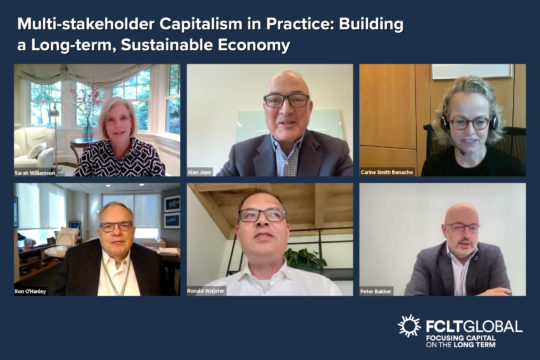What does it take to earn a return from implementing a multi-stakeholder strategy and offer a rebuttal to skeptics? To answer this question, we turned toward empirical analysis, comparing the characteristics and performance of companies pursuing various stakeholder-oriented strategies. Partnering with the ESG Analytics Lab at the Wharton School, University of Pennsylvania, we analyzed the annual reports of over 3,000 global companies (drawn from MSCI’s All Country World Index) to look for stakeholder-oriented language, and we compared the presence of that language with financial, environmental, social and governance (ESG) outcomes. Controlling for sector-specific effects, we found firms that paired strong stakeholder language (“the talk”) with strong performance on material ESG measures (“the walk”):
- Generated 4% higher returns over a three-year period as measured by return on invested capital (ROIC);
- Were more likely to meaningfully invest in research and development (R&D), investing twice as much in R&D as a percentage of sales;
- Were 50% more likely to issue long-term guidance;
- Delivered higher sales growth over longer periods of time (1.5% higher over three years); and
- Delivered more stable returns, resulting in 9% lower predicted ROIC volatility over three years.
At the highest level, if all firms performed like companies in the top walk/talk tercile, they would combine to generate $3.2 trillion in additional firm value over our 11-year study period.
That’s not to say that shareholder-centric strategies don’t pay off. In the short run, firms focused primarily on their shareholders also perform well. But the positive effects of an approach to business that over-indexes to a single group of stakeholders (to the exclusion of others) appear to fade over longer periods of time. Those over-indexed firms also produce more volatile performance (as measured by the standard deviation in ROIC) compared with multi-stakeholder-oriented firms, making firms with a narrow focus less resilient in a rapidly evolving operating environment. In essence – while there is often a natural gravitational pull to prioritize one set of stakeholders over another (shareholders in many cases), prioritizing one group continuously is not a winning long-term strategy.
True multi-stakeholder approaches (high talk/high walk) may take time to yield benefits. High talk/high walk firms had higher sales growth in the long run (over more than three years), but initially, in the short run (zero- and oneyear periods) the firms that had high talk and low walk scores did better. Essentially, there is some meaningless stakeholder talk: firms high on talk but low on walk underperform on many metrics of success over time. But talk can also be a leading indicator of improving returns. Firms that start using more stakeholder-oriented language and then back it up over time with improving walk metrics also do better. Separating the empty talk from the talk of companies that may simply be earlier in their journey is a challenge for stakeholders (especially investors) – one that companies can address with more consistent communications about their multi-stakeholder strategies.
Future-fit, long-term companies need more durable performance to succeed – and that requires attention to a broader group of stakeholders. Using corporate purpose – the reason that a firm exists – as the reference point for deciding which stakeholder expectations matter to the corporation helps put a multi-stakeholder strategy into practice more consistently. Companies will have different stakeholders and varying stakeholder strategies because their purposes are different. Nevertheless, firms that connect their purpose to their key stakeholder responsibilities systematically across their organizations are better able to sustainably deliver long-term value – the goal of any corporation.
Download Walking the Talk: Valuing a Multi-Stakeholder Strategy


